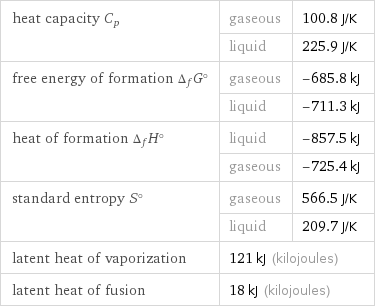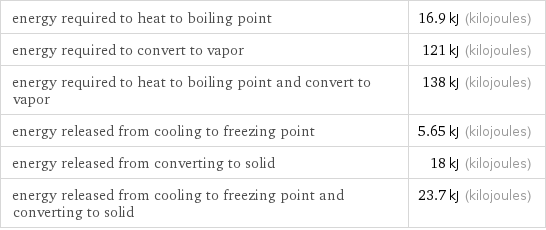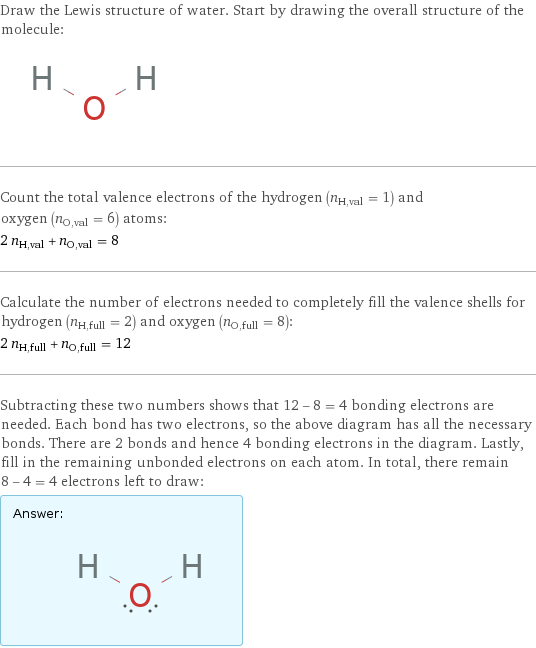Input interpretation

3 mol of water
Basic properties for 3 mol

mass | 54 grams 0.054 kg (kilograms) 0.119 lb (pounds) 1.91 oz (ounces) molar amount | 3 mol (moles) volume | 54 mL (milliliters) 0.054 L (liters) 54 cm^3 (cubic centimeters) 5.4×10^-5 m^3 (cubic meters) 0.228 cups 1.83 fl oz (fluid ounces) 11 tsp (teaspoons) 3.65 tbsp (tablespoons) 0.114 pints 0.0571 quarts 0.0143 gallons equivalents | 3 eq (equivalents) (at STP)
Thermodynamic properties for 3 mol

heat capacity C_p | gaseous | 100.8 J/K | liquid | 225.9 J/K free energy of formation Δ_fG° | gaseous | -685.8 kJ | liquid | -711.3 kJ heat of formation Δ_fH° | liquid | -857.5 kJ | gaseous | -725.4 kJ standard entropy S° | gaseous | 566.5 J/K | liquid | 209.7 J/K latent heat of vaporization | 121 kJ (kilojoules) | latent heat of fusion | 18 kJ (kilojoules) |
Units

Energy vs. temperature for 3 mol

(relative to STP)
Units

Phase change energies for 3 mol from 25 °C

energy required to heat to boiling point | 16.9 kJ (kilojoules) energy required to convert to vapor | 121 kJ (kilojoules) energy required to heat to boiling point and convert to vapor | 138 kJ (kilojoules) energy released from cooling to freezing point | 5.65 kJ (kilojoules) energy released from converting to solid | 18 kJ (kilojoules) energy released from cooling to freezing point and converting to solid | 23.7 kJ (kilojoules)
Corresponding quantities

sphere radius | 2.345 cm (centimeters) side of a cube | 3.781 cm (centimeters)
Mass composition for 3 mol

H (hydrogen) | 6.048 g (11.2%) O (oxygen) | 48.000 g (88.8%)

Mass composition for 3 mol
Lewis structure

Draw the Lewis structure of water. Start by drawing the overall structure of the molecule: Count the total valence electrons of the hydrogen (n_H, val = 1) and oxygen (n_O, val = 6) atoms: 2 n_H, val + n_O, val = 8 Calculate the number of electrons needed to completely fill the valence shells for hydrogen (n_H, full = 2) and oxygen (n_O, full = 8): 2 n_H, full + n_O, full = 12 Subtracting these two numbers shows that 12 - 8 = 4 bonding electrons are needed. Each bond has two electrons, so the above diagram has all the necessary bonds. There are 2 bonds and hence 4 bonding electrons in the diagram. Lastly, fill in the remaining unbonded electrons on each atom. In total, there remain 8 - 4 = 4 electrons left to draw: Answer: | |
Chemical names and formulas

formula | H_2O Hill formula | H_2O name | water IUPAC name | water
Substance properties

molar mass | 18.015 g/mol phase | liquid (at STP) melting point | 0 °C boiling point | 99.9839 °C density | 1 g/cm^3 surface tension | 0.0728 N/m dynamic viscosity | 8.9×10^-4 Pa s (at 25 °C) odor | odorless
Units
